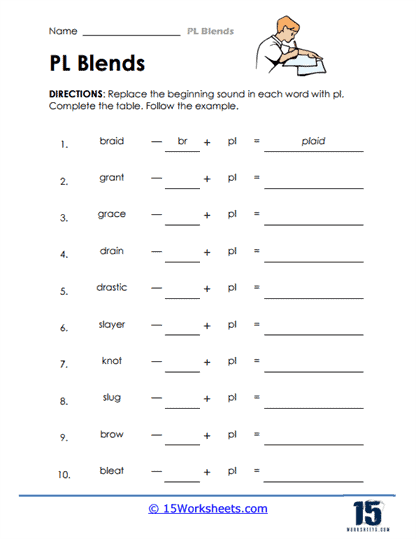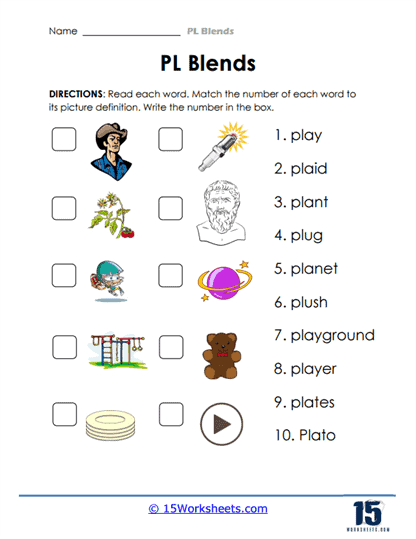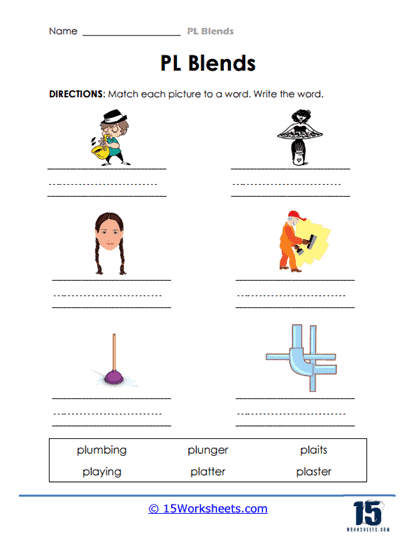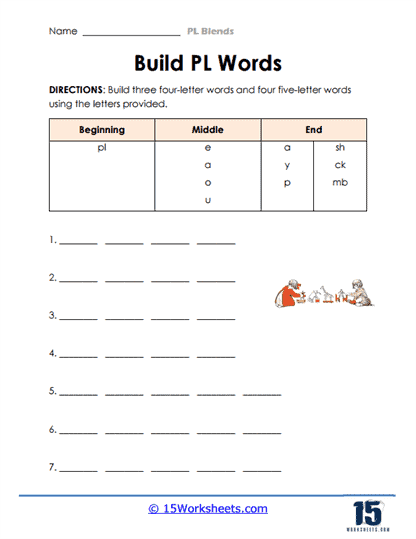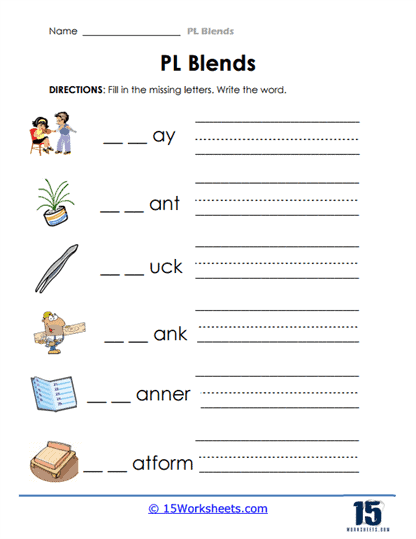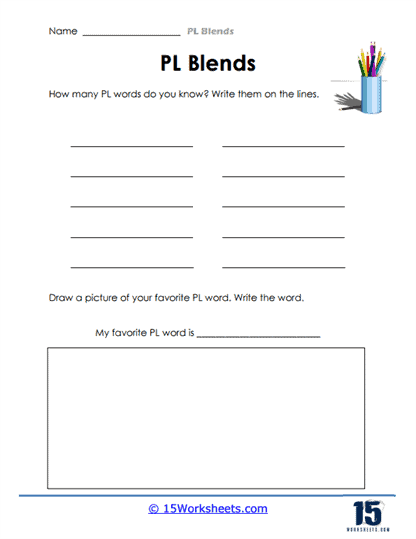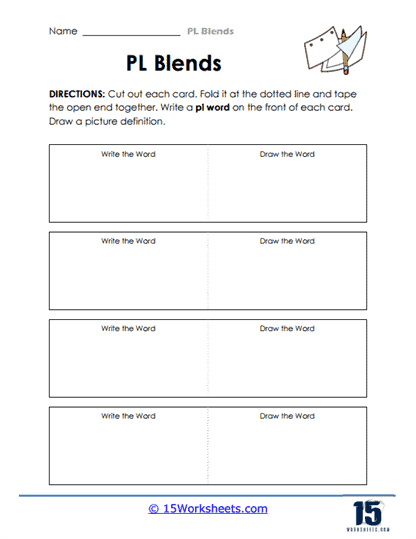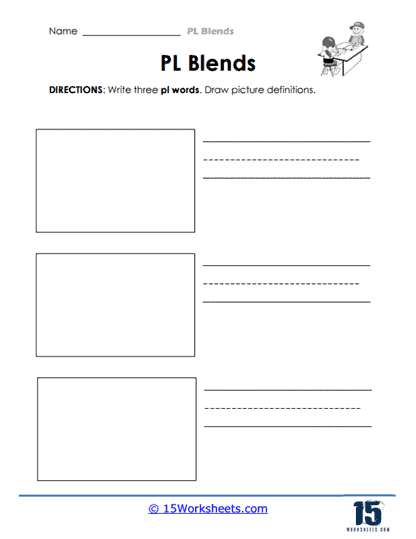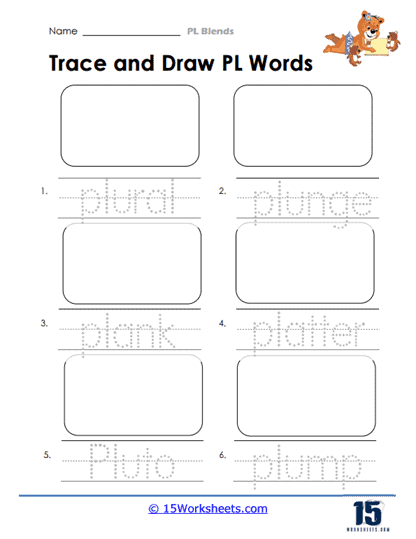Pl Blends Worksheets
All About These 15 Worksheets
Phonics is a foundational skill in literacy and language development. Among its aspects, the mastery of consonant blends is crucial for students as they learn to read and write effectively. Consonant blends, such as PL blends (combinations of the consonants ‘p’ and ‘l’), are essential components of the English language.
To support students in mastering PL blends and strengthening their phonics skills, we present a collection of PL Blends worksheets. These worksheets have been thoughtfully designed to provide students with structured and engaging opportunities to practice and refine their PL blend skills.
What Are PL Blends Worksheets?
These PL blend Worksheets will help children recognize, understand, and utilize the “pl” consonant blend in their reading and writing. This blend combines the sounds of “p” and “l” to create words like “plane,” “play,” and “plus.” Recognizing this blend helps kids decode (read) and encode (spell) words more efficiently. By focusing on this specific blend, these worksheets ensure that the foundational building blocks of reading are firmly established.
PL Blends worksheets are integral to building and strengthening the phonics foundation. They offer structured, varied, and engaging methods to ensure their child grasps the “pl” blend. By doing so, they’re not just teaching a blend; they’re improving their child’s overall reading fluency and comprehension.
Different exercises cater to different learning styles and stages, allowing for a tailored approach that can be adjusted based on progress and needs. In sum, as you homeschool, incorporating such specialized worksheets into your literacy instruction ensures a well-rounded and thorough understanding of the English language’s intricate sound-letter relationships.
Phonics, the method of teaching reading and writing by correlating sounds with symbols in an alphabetic writing system, plays a significant role in this. Within phonics, understanding consonant blends, like the “pl” blend, is crucial. That’s where Pl Blends Worksheets come into play. Here are the types of activities that these worksheets have and what they offer your students.
Picture and Word Matching – A straightforward exercise where children are given pictures representing “pl” blend words. Next to these images, there’s a list of words. The task is to match each picture to the corresponding “pl” blend word. For example, a picture of a planet would match with the word “planet.”
Fill in the Blanks – Children are presented with incomplete words where the “pl” blend is missing. For instance, with the word “pluck,” the worksheet might display “___uck.” The objective is to fill in the missing “pl.”
Word Search – This activity transforms learning into a fun challenge. A grid of letters hides various “pl” blend words, and children are tasked to find them.
Sentence Completion – Here, students encounter sentences with missing words. The goal is to use context clues to fill in the gaps with appropriate “pl” blend words. For instance, “He loves to ___ with his toys,” where the answer would be “play.”
Sorting Activities – Children are presented with a mixture of words. They need to sort these into two categories – words that have the “pl” blend and those that don’t. This reinforces their recognition skills.
Blending Practice – Often used in the early stages of phonics instruction, kids practice blending the individual /p/ and /l/ sounds to produce the /pl/ blend.
Pl Blend Bingo – Much like the traditional Bingo but tailored for phonics, children have cards populated with “pl” blend words. As words or associated pictures are called out, they mark them.
Cut and Paste Activities – Here, kids get hands-on. They’re given separate lists of “pl” blend words and images. Their task is to match the word to the right image by cutting and pasting them together.
Spelling Practice – To bolster writing skills, children may be given lists of “pl” blend words to practice their spelling. They might rewrite words, construct their own sentences with them, or engage in dictation.
Rhyming Words – Phonics often ties into phonemic awareness. These exercises prompt children to identify or think of words that rhyme with a provided “pl” blend word. If “plum” is given, a rhyming word might be “gum.”
The Importance of PL Blends
Understanding and mastering PL blends is of paramount importance for several reasons:
- Reading Proficiency: PL blends are commonly found in many words, and being able to recognize and pronounce them accurately is vital for fluent reading.
- Spelling Competence: Proficiency in PL blends enhances students’ spelling skills. When they can identify and use PL blends correctly, they are more likely to spell words accurately.
- Vocabulary Building: Learning PL blends exposes students to a broader range of words, enriching their vocabulary and comprehension.
- Effective Communication: Proficiency in PL blends sharpens students’ listening skills and aids them in comprehending spoken language. This is a valuable skill for effective communication both in the classroom and in real-world situations.
This collection of PL Blends worksheets is a valuable resource for educators and parents committed to supporting their students’ phonics and literacy development. Proficiency in PL blends is not just an academic exercise; it’s a fundamental skill that opens the doors to effective communication and language proficiency.
By using these engaging worksheets, students will strengthen their ability to read, write, and understand language with confidence. This collection is an investment in their future success, ensuring they have a solid foundation in PL blends, phonemic awareness, spelling, and vocabulary.
List of Commonly Used Pl Blend Words
- Place
- Placeholder
- Placid
- Placidly
- Plague
- Plan
- Plane
- Plank
- Plant
- Plaster
- Plastic
- Plate
- Platform
- Platoon
- Platter
- Plausible
- Play
- Player
- Playful
- Playground
- Playhouse
- Playpen
- Playroom
- Plaza
- Plead
- Please
- Pleasure
- Pledge
- Plenty
- Plight
- Plod
- Plop
- Plot
- Plow (or Plough)
- Plowman
- Pluck
- Plug
- Plum
- Plumb
- Plumber
- Plume
- Plume
- Plump
- Plunge
- Plunge
- Plural
- Plural
- Pluralize
- Plus
- Plush




